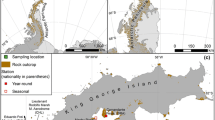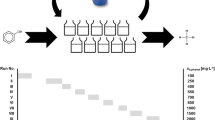Abstract
In this study, three cold-tolerant phenol-degrading strains, Pseudomonas veronii Ju-A1 (Ju-A1), Leifsonia naganoensis Ju-A4 (Ju-A4), and Rhodococcus qingshengii Ju-A6 (Ju-A6), were isolated. All three strains can produce cis, cis-muconic acid by ortho-cleavage of catechol at 12 ℃. Response surface methodology (RSM) was used to optimize the proportional composition of low-temperature phenol-degrading microbiota. Degradation of phenol below 160 mg L−1 by low-temperature phenol-degrading microbiota followed first-order degradation kinetics. When the phenol concentration was greater than 200 mg L−1, the overall degradation trend was in accordance with the modified Gompertz model. The experiments showed that the microbial agent (three strains of low-temperature phenol-degrading bacteria were fermented separately and constructed in the optimal ratio) could completely degrade 200 mg L−1 phenol within 36 h. The above construction method is more advantageous in bio-enhanced treatment of actual wastewater. Through the construction of microbial agents to enhance the degradation effect of phenol, it provides a feasible scheme for the biodegradation of phenol wastewater at low temperature and shows good application potential.
Graphical abstract










Similar content being viewed by others
Data availability
The datasets generated during and/or analyzed during the current study are available from the corresponding author on reasonable request.
References
Ali S, Fernandez-Lafuente R, Cowan DA (1998) Meta-pathway degradation of phenolics by thermophilic Bacilli. Enzyme Microb Technol 23:462–468. https://doi.org/10.1016/S0141-0229(98)00072-6
Alva VA, Peyton BM (2003) Phenol and Catechol Biodegradation by the Haloalkaliphile Halomonas campisalis: Influence of pH and Salinity. Environ Sci Technol 37:4397–4402. https://doi.org/10.1021/es0341844
Bai X, Nie M, Diwu Z, Wang L, Nie H, Wang Y, Yin Q, Zhang B (2022) Simultaneous biodegradation of phenolics and petroleum hydrocarbons from semi-coking wastewater: construction of bacterial consortium and their metabolic division of labor. Bioresour. Technol 347:126377. https://doi.org/10.1016/j.biortech.2021.126377
Basile LA, Erijman L (2008) Quantitative assessment of phenol hydroxylase diversity in bioreactors using a functional gene analysis. Appl Microbiol Biotechnol 78:863–872. https://doi.org/10.1007/s00253-008-1351-3
Bradford MM (1976) Rapid and sensitive method for quantification of microgram quantities of proteins using principle of protein-dye binding. Anal Biochem 72:248–254. https://doi.org/10.1016/0003-2697(76)90527-3
Chen H, Wang Y, Lv YK (2021) Simultaneous removal characteristics of ammonium and phenol by Alcaligenes faecalis strain WY-01 with the addition of acetate. Bioprocess Biosyst Eng 44:27–38. https://doi.org/10.1007/s00449-020-02416-3
Chen W-H, Carrera Uribe M, Kwon EE, Lin K-YA, Park Y-K, Ding L, Saw LH (2022) A comprehensive review of thermoelectric generation optimization by statistical approach: Taguchi method, analysis of variance (ANOVA), and response surface methodology (RSM). Renew Sust Energy Rev 169:112917. https://doi.org/10.1016/j.rser.2022.112917
Collado N, Buttiglieri G, Marti E, Ferrando-Climent L, Rodriguez-Mozaz S, Barceló D, Comas J, Rodriguez-Roda I (2013) Effects on activated sludge bacterial community exposed to sulfamethoxazole. Chemosphere 93(1):99–106. https://doi.org/10.1016/j.chemosphere.2013.04.094
Dalvi S, Azetsu S, Patrauchan MA, Aktas DF, Fathepure BZ (2012) Proteogenomic elucidation of the initial steps in the benzene degradation pathway of a novel halophile, Arhodomonas sp. strain Rozel, isolated from a hypersaline environment. Appl Environ Microbiol 78:7309–7316. https://doi.org/10.1128/AEM.01327-12
Deng Y, Mao Y, Li B, Yang C, Zhang T (2016) Aerobic Degradation of sulfadiazine by Arthrobacter spp.: kinetics, pathways, and genomic characterization. Environ Sci Technol 50:9566–9575. https://doi.org/10.1021/acs.est.6b02231
Dhamale T, Saha BK, Papade SE, Singh S, Phale PS (2022) A unique global metabolic trait of Pseudomonas bharatica CSV86(T): metabolism of aromatics over simple carbon sources and co-metabolism with organic acids. Microbiology-SGM. https://doi.org/10.1099/mic.0.001206
Dos Santos VL, Monteiro Ade S, Braga DT, Santoro MM (2009) Phenol degradation by Aureobasidium pullulans FE13 isolated from industrial effluents. J Hazard Mater 161:1413–1420. https://doi.org/10.1016/j.jhazmat.2008.04.112
Girolamini L, Salaris S, Pascale MR et al (2022) Dynamics of legionella community interactions in response to temperature and disinfection treatment: 7 years of investigation. Microb Ecol 83:353–362. https://doi.org/10.1007/s00248-021-01778-9
Gong ZW, Zhou WT, Shen HW, Zhao ZK, Yang ZH, Yan JB, Zhao M (2016) Co-utilization of corn stover hydrolysates and biodiesel-derived glycerol by Cryptococcus curvatus for lipid production. Bioresour Technol 219:552–558. https://doi.org/10.1016/j.biortech.2016.08.021
Gong Z, Zhao M, He Q et al (2022) Synergistic effect of glucose and glycerol accelerates microbial lipid production from low-cost substrates by Cutaneotrichosporon oleaginosum. Biomass Conv Bioref. https://doi.org/10.1007/s13399-022-02369-5
He YZ, Wang ZN, Li TY, Peng XX, Tang YT, Jia XS (2022) Biodegradation of phenol by Candida tropicalis sp.: kinetics, identification of putative genes and reconstruction of catabolic pathways by genomic and transcriptomic characteristics. Chemosphere. https://doi.org/10.1016/j.chemosphere.2022.136443
Hou B, Zhang R, Liu X, Li Y, Liu P, Lu J (2021) Study of membrane fouling mechanism during the phenol degradation in microbial fuel cell and membrane bioreactor coupling system. Bioresour Technol 338:125504. https://doi.org/10.1016/j.biortech.2021.125504
Hughes SM, Cooper DG (1996) Biodegradation of phenol using the self-cycling fermentation (SCF) process. Biotechnol Bioeng 51:112–119. https://doi.org/10.1002/(SICI)1097-0290(19960705)51:1%3c112::AID-BIT13%3e3.0.CO;2-S
Kim JH, Block DE, Mills DA (2010) Simultaneous consumption of pentose and hexose sugars: an optimal microbial phenotype for efficient fermentation of lignocellulosic biomass. Appl Microbiol Biotechnol 88:1077–1085. https://doi.org/10.1007/s00253-010-2839-1
Kim B, Park H, Na D, Lee SY (2014) Metabolic engineering of Escherichia coli for the production of phenol from glucose. Biotechnol J 9:621–629. https://doi.org/10.1002/biot.201300263
Kumar A, Kumar S, Kumar S (2005) Biodegradation kinetics of phenol and catechol using Pseudomonas putida MTCC 1194. Biochem Eng J 22:151–159. https://doi.org/10.1016/j.bej.2004.09.006
Lee GLY, Zakaria NN, Futamata H, Suzuki K, Zulkharnain A, Shaharuddin NA, Convey P, Zahri KNM, Ahmad SA (2022) Metabolic pathway of phenol degradation of a cold-adapted antarctic bacteria, Arthrobacter sp. Catalysts 12:1422. https://doi.org/10.3390/catal12111422
Lefebvre O, Moletta R (2006) Treatment of organic pollution in industrial saline wastewater: a literature review. Water Res 40:3671–3682. https://doi.org/10.1016/j.watres.2006.08.027
Li F, Pang Y, Lou H, Qiu X (2023) Synthesis of temperature and pH responsive lignin-grafted sulfobetaine for efficiently recycling cellulase. Bioresour Technol 369:128357. https://doi.org/10.1016/j.biortech.2022.128357
Loh K-C, Chua S-S (2002) Ortho pathway of benzoate degradation in Pseudomonas putida: induction of meta pathway at high substrate concentrations. Enzyme Microb Technol 30:620–626. https://doi.org/10.1016/S0141-0229(02)00016-9
Mahiudddin M, Fakhruddin AN, Abdullah Al M (2012) Degradation of phenol via meta cleavage pathway by Pseudomonas fluorescens PU1. ISRN Microbiol 2012:741820. https://doi.org/10.5402/2012/741820
Margesin R, Bergauer P, Gander S (2004) Degradation of phenol and toxicity of phenolic compounds: a comparison of cold-tolerant Arthrobacter sp. and mesophilic Pseudomonas putida. Extremophiles 8:201–207. https://doi.org/10.1007/s00792-004-0378-3
Nakazawa T, Nakazawa A (1970) Pyrocatechase (pseudomonas). Methods in enzymology. Academic Press, pp 518–522. https://doi.org/10.1016/0076-6879(71)17234-5
Nandy S, Arora U, Tarar P, Viggor S, Joesaar M, Kivisaar M, Kapley A (2021) Monitoring the growth, survival, and phenol utilization of the fluorescent-tagged Pseudomonas oleovorans immobilized and free cells. Bioresour Technol 338:125568. https://doi.org/10.1016/j.biortech.2021.125568
Nie H, Nie M, Yang Y, Zhao J, Zhang X, Guo Y, Wan Y, Zi J (2015) Characterization of phenol metabolization by P. stutzeri N2. Polycyclic Aromat Compd 36:587–600. https://doi.org/10.1080/10406638.2015.1033434
Nowak A, Wasilkowski D, Mrozik A (2022) Implications of bacterial adaptation to phenol degradation under suboptimal culture conditions involving Stenotrophomonas maltophilia KB2 and Pseudomonas moorei KB4. Water 14:2845. https://doi.org/10.3390/w14182845
Paisio CE, Talano MA, Gonzalez PS, Busto VD, Talou JR, Agostini E (2012) Isolation, and characterization of a Rhodococcus strain with phenol-degrading ability and its potential use for tannery effluent biotreatment. Environ Sci Pollut Res Int 19:3430–3439. https://doi.org/10.1007/s11356-012-0870-8
Palla CA, Pacheco C, Carrín ME (2012) Production of structured lipids by acidolysis with immobilized Rhizomucor miehei lipases: selection of suitable reaction conditions. J Mol Catal B Enzym 76:106–115. https://doi.org/10.1016/j.molcatb.2011.11.022
Pan G, Kurumada K-I (2008) Hybrid gel reinforced with coating layer for removal of phenol from aqueous solution. Chem Eng J 138:194–199. https://doi.org/10.1016/j.cej.2007.06.025
Rea VSG, Sierra JDM, El-Kalliny AS, Cerqueda-Garcia D, Lindeboom REF, Spanjers H, van Lier JB (2023) Syntrophic acetate oxidation having a key role in thermophilic phenol conversion in anaerobic membrane bioreactor under saline conditions. Chem Eng J. https://doi.org/10.1016/j.cej.2022.140305
Robles A, Lucas R, De Cienfuegos GA, Gálvez A (2000) Phenol-oxidase (laccase) activity in strains of the hyphomycete Chalara paradoxa isolated from olive mill wastewater disposal ponds. Enzyme Microb Technol 26:484–490. https://doi.org/10.1016/S0141-0229(99)00197-0
Sachan DS (2019) Revisiting lstm networks for semi-supervised text classification via mixed objective function. AAAI 2019:1
Shahryari S, Zahiri HS, Haghbeen K, Adrian L, Noghabi KA (2018) High phenol degradation capacity of a newly characterized Acinetobacter sp. SA01: bacterial cell viability and membrane impairment in respect to the phenol toxicity. Ecotoxicol Environ Saf 164:455–466. https://doi.org/10.1016/j.ecoenv.2018.08.051
Shen J, He R, Yu H, Wang L, Zhang J, Sun X, Li J, Han W, Xu L (2009) Biodegradation of 2,4,6-trinitrophenol (picric acid) in a biological aerated filter (BAF). Bioresour Technol 100:1922–1930. https://doi.org/10.1016/j.biortech.2008.10.018
Shetty GR, Shetty VK (2015) Pathway identification, enzyme activity and kinetic study for the biodegradation of phenol by Nocardia hydrocarbonoxydans NCIM 2386. Desalin Water Treat 57:8789–8801. https://doi.org/10.1080/19443994.2015.1030700
Singh NS, Sharma R, Singh DK (2019) Identification of enzyme(s) capable of degrading endosulfan and endosulfan sulfate using in silico techniques. Enzyme Microb Technol 124:32–40. https://doi.org/10.1016/j.enzmictec.2019.01.003
Singh S, Bharadwaj T, Verma D, Dutta K (2022) Valorization of phenol contaminated wastewater for lipid production by Rhodosporidium toruloides 9564T. Chemosphere 308:136269. https://doi.org/10.1016/j.chemosphere.2022.136269
Su S, Liao L, Yu Y, Zhang J, Chen B (2019) Genomic data mining of an Antarctic deep-sea actinobacterium, Janibacter limosus P3–3-X1. Mar Genomics 48:100684. https://doi.org/10.1016/j.margen.2019.04.009
Sun S, Wan X, Bian Y, Wang S, Zhang J, Wang W (2023) Biologically evolved dual-pathway catalytic pattern indicating an efficient bioremediation strategy for phenol removal. Chem Eng J 454:140195. https://doi.org/10.1016/j.cej.2022.140195
Tros ME, Bosma TN, Schraa G, Zehnder AJ (1996) Measurement of minimum substrate concentration (Smin) in a recycling fermentor and its prediction from the kinetic parameters of Pseudomonas strain B13 from batch and chemostat cultures. Appl Environ Microbiol 62:3655–3661. https://doi.org/10.1128/aem.62.10.3655-3661.1996
Varmira K, Habibi A, Moradi S, Bahramian E (2016) Statistical optimization of airlift photobioreactor for high concentration production of torularhodin pigment. Biocatal Agric Biotechnol 8:197–203. https://doi.org/10.1016/j.bcab.2016.09.013
Vogt C, Simon D, Alfreider A, Babel W (2004) Microbial degradation of chlorobenzene under oxygen-limited conditions leads to accumulation of 3-chlorocatechol. Environ Toxicol Chem 23:265–270. https://doi.org/10.1897/02-446
Wang Y, Wang H, Wang X, Xiao Y, Zhou Y, Su X, Cai J, Sun F (2020) Resuscitation, isolation, and immobilization of bacterial species for efficient textile wastewater treatment: a critical review and update. Sci Total Environ 730:139034. https://doi.org/10.1016/j.scitotenv.2020.139034
Wen Y, Li C, Song X, Yang Y (2020) Biodegradation of phenol by Rhodococcus sp. strain SKC: characterization and kinetics study. Molecules. https://doi.org/10.3390/molecules25163665
Zhou P, Wan J, Wang X, Chen J, Gong Y, Xu K (2019) Three-dimensional hierarchical porous carbon cathode derived from waste tea leaves for the electrocatalytic degradation of phenol. Langmuir 35:12914–12926. https://doi.org/10.1021/acs.langmuir.9b02017
Funding
This work was financially supported by the Fundamental Research Funds for the Central Universities (No. DUT22LAB131).
Author information
Authors and Affiliations
Contributions
YY: investigation, experimental design, methodology, writing—original draft. YZ: conceptualization, formal analysis, supervision. CL: software, validation. ZS: data curation. RZ: investigation. JZ: review and editing.
Corresponding author
Ethics declarations
Conflict of interest
The authors have no relevant financial or non-financial interests to disclose.
Consent to participate
Informed consent was obtained from all individual participants included in the study.
Consent to publish
Additional informed consent was obtained from all individual participants for whom identifying information is included in this article.
Additional information
Communicated by Arivalagan Pugazhendhi.
Publisher's Note
Springer Nature remains neutral with regard to jurisdictional claims in published maps and institutional affiliations.
Supplementary Information
Below is the link to the electronic supplementary material.
Rights and permissions
Springer Nature or its licensor (e.g. a society or other partner) holds exclusive rights to this article under a publishing agreement with the author(s) or other rightsholder(s); author self-archiving of the accepted manuscript version of this article is solely governed by the terms of such publishing agreement and applicable law.
About this article
Cite this article
Yang, Y., Zhang, Y., Liu, C. et al. Low-temperature phenol-degrading microbial agent: construction and mechanism. Arch Microbiol 205, 193 (2023). https://doi.org/10.1007/s00203-023-03532-w
Received:
Revised:
Accepted:
Published:
DOI: https://doi.org/10.1007/s00203-023-03532-w




